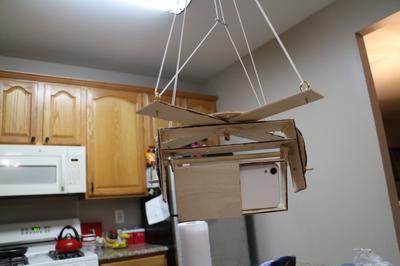First Attempt at Kite Aerial Photography
by Dan Prosser
(Maryland, USA)

The KAP rig
Today was my first attempt at kite aerial photography (KAP). The winds were a bit questionable all day; probably enough to fly my big ripstop Dopero, but without much extra to spare for weight lifting.
By the late afternoon, there seemed to be a decently steady breeze of about 8 mph, so I decided to take it and the brand new picavet rig I had just completed down to the local park.
Before talking about the flight, let me describe the KAP rig itself. It is made mostly out of 3 mm plywood and designed to lift a cell phone or small camera. The pitch angle of the rig can be adjusted from 0 degrees (looking straight ahead) to 90 degrees (looking straight down) in 22.5-degree incrememnts, and the yaw angle from 0 to 360 degrees in 45-degree increments. Once you settle on the desired angles, some toggles made out of 3/16" dowels hold it in place. I set it at 22.5 degrees down for the first flight. I am using an old cell phone with an app called OpenCamera, which provides an intervalometer function and can fix focus to infinity. The whole rig, including the phone, weighs less than a pound.
The very first attempt at flight was "interesting." I first flew the kite for about a minute just to make sure the bridle was adjusted correctly. Then I set the kite in the grass standing up and ready to be pulled into action, unwound about 40 feet of string, and attached the camera rig about half that distance from the kite. I started the camera (or so I thought) and gave the line a firm tug to pull everything up into the air. The picavet rig swung wildly as I ran backwards into the wind, letting out line as I went, trying to gain altitude. That's when I found out that, apparently, the bridle point was too high for KAP work. The extra weight of the rig pitched the nose of the kite down whenever there was a strong tug on the line, causing it to lose lift and start fluttering back to Earth. After a couple cycles of this, I decided I'd better land and adjust the bridle. As it turned out, I was fortunate, because for some reason the camera had taken only one picture and then stopped! It would have been a bummer to do a whole flight only to realize no pictures had been taken in the air.
After moving the bridle a couple inches towards the tail and trying to launch again, the flight behavior was much better. Getting it up into smooth air was still a bit of an adventure, as the camera rig tends to destabilize the kite, but after running the whole length of the soccer field, it was up well above treetop level at an altitude where it could be controlled with just the winder! This time the camera continued to take pictures of the park and nearby town.
Bringing the whole thing down wasn't too hard, since the wind wasn't that strong. I found that it worked well to walk towards the kite while winding it in, which reduced the tension and also gave more room to back up again in case I should need it. Once the kite got below treetop level, things started to get a little interesting again. I should have just let it settle down gently once it got down to 50 feet of line left, but I kept winding it in, only to pull it to a higher angle while simultaneously losing lift. At that point, control was lost and the camera rig came swinging down and stopped on the grass after a couple cartwheels. There was no damage, but like I said, it was interesting! Something to learn from for next time anyway.
Next time I will also add some more line (since the legal limit for altitude is 500 feet here, and it definitely didn't reach that with the 500 feet of line I brought), and maybe get a better camera, since this old phone doesn't take the best pictures. I've attached a few of the pictures that came out the best, along with a picture of the rig and the kite + rig in the air as seen from the ground.
Return to YOUR Kite Aerial Photography!.
As mentioned earlier, there's more kite making on this site than you can poke a stick at. :-)
Want to know the most convenient way of using it all?
The Big MBK E-book Bundle is a collection of downloads—printable PDF files that provide step-by-step instructions for many kites large and small.
That's every kite in every MBK series.







